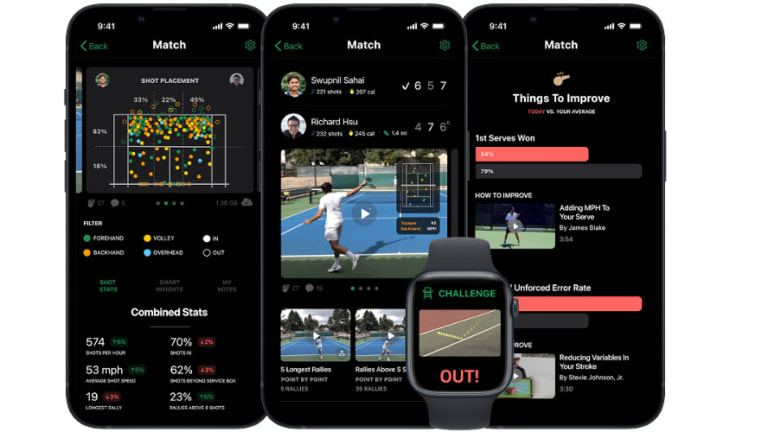Pro players pay a king’s ransom for match tracking data, but with SwingVision all it takes is a smartphone. Using artificial intelligence, the app records a match or training session and turns it into a highlight reel of memorable points and a trove of stats. Points played, ball speed, shot placement and distribution, rally length, court positioning—just about every valuable measurable is covered. If that weren’t enough, it can even call the lines. Whether it’s to improve performance or just pure entertainment, this app brings a lot of game to the court.
Setup
With numerous how-to videos to expedite the process, getting started with SwingVision isn’t overly difficult, but it may still require some trial-and-error before it’s completely routine. First thing that’s needed is downloading the SwingVision app. It’s currently only available for iOS devices, but will be Android compatible next year.
The other necessary piece of equipment is a mount to position the phone in the back of the court for recording. SwingVision recommends a top of the fence mount —and sells its own model ($60)—as it affords the best viewing angle and the most accurate stats. However, any functional mount or attachment can also work. A tripod is a third option, but only recommended if playing in a bubble or somewhere without a fence or curtain. Ideally the phone should be high enough and far enough beyond the baseline to get a view of the entire court.
Once secure in the mount, the app is then opened to get the phone’s perspective. The camera needs to be angled so that both baselines and alleys are visible. This can be a little tricky as what you see at eye level may not be what you want when the phone is mounted on top of the fence. This is one of those areas where some practice makes perfect.
A smoother and faster way to do this, however, is with the assistance of an Apple Watch. Once the phone is positioned on the fence, you can open the SwingVision app on the watch and get a real-time camera view. If everything is correctly lined up just hit the record button on the watch and start the session.
Features
The watch not only aids setup, but serves other functions such as keeping score and favoriting rallies for post-match viewing. But perhaps its most innovative and useful attribute is challenging line calls. After a point is completed, tap the “challenge” button on the watch to see a video playback of a close-up of the ball bouncing and a determination of whether it was in or out. You can even scroll back to each shot of the point to see if you played an out ball that received the benefit of the doubt. In terms of reliability, testing has shown the app to be more accurate than human eyes for shots landing within 10 cm of a line on both sides of the court. Far more often than not, my playing partners and I were in agreement with SwingVision’s line calls.
If you’re not already used to playing with a watch or fitness band on your wrist, it can be an adjustment. I typically play with a thick sweatband instead, and kept futilely trying to dab my brow with my watch. A drawback for some, but regular Apple Watch wearers often keep theirs on during exercise.

